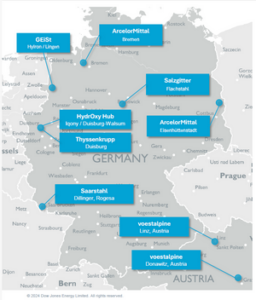Green Steel Will Become the New Norm, but the Devil is in the Details
Featuring insights from the European Green Steel Profile report, published by McCloskey on November 20, 2024
Three years ago, the EU adopted the European Climate Law, mandating a 55% reduction in greenhouse gas (GHG) emissions by 2030 (compared to 1990 levels) and carbon neutrality by 2050. Instruments such as the Emissions Trading System (ETS) and the Carbon Border Adjustment Mechanism (CBAM) have been put in place to incentivize steelmakers to change their production methods. The European Commission has approved billions of euros in state aid to help companies navigate the costly technological transformation.
Today, three years later, after analyzing over 40 transition initiatives for the European Green Steel Profile report, we can say that the carrot and stick strategy works. Every major European producer has a portfolio of green steel projects that are at least in the advanced planning stage, some already under construction and expected to become operational as early as 2026.
Yes, the European steel industry is going through difficult times due to weakening demand and high energy costs. However, the crisis can slow the green transition but not stop it. Dozens of projects have been launched, substantial investments committed, and state aid allocated. Plus, companies have been planning with the market realities in mind, hoping for a “deus ex machina” while leaving room to adjust timelines if necessary.
Our calculations, based on a case-by-case analysis, show that over the next decade, major European steelmakers will phase out more than 50 million tonnes per annum (mtpa) of traditional steel capacity produced via the blast furnace-basic oxygen furnace (BF/BOF) route. This will be replaced by over 70 mtpa of low-carbon steel, mainly produced through the direct reduced iron-electric arc furnace (DRI/EAF) or direct reduced iron-electric smelter furnace-basic oxygen furnace (DRI/ESF/BOF) route, of which over 12 mtpa will come from greenfield projects. This is more than what was produced via the BF/BOF route in 2023 in the EU (69.8 mt), and more than half of all steel produced in the EU (126.2 mt). This trend indicates that in about a decade, green steel, which is already coming to the market as a premium product, will become a new industry standard.
Of course, the shift to low-carbon steelmaking will not happen all at once, like a “green tsunami” that would overturn the market. Each company has its own pace and strategy for greenfields or replacements, with phases spread over the decade and beyond. Long-term purchase contracts are concluded years in advance. However, the European Green Steel Profile report shows potential peak years when most of new capacity will come online.
The report also provides a description of individual projects, helping to predict the carbon footprint of steel based on the applied technologies and available resources such as green hydrogen or renewable electricity. In other words, whose steel will be “greener.” Today’s emerging green steel market is only beginning to assess the carbon component of the steel price, but the CO2 footprint is expected to become a key defining characteristic of the green steel premium in the near future.
 The country factor is also important for understanding the trends, as it usually reflects the fundamental availability of green resources and levels of state support. It defines the substance and scale of the projects.
The country factor is also important for understanding the trends, as it usually reflects the fundamental availability of green resources and levels of state support. It defines the substance and scale of the projects.
Take Sweden, for example, which hosts two of the three largest projects in the Nordic region—Stegra and HYBRIT. They include a complete production chain from green hydrogen electrolysis to the H2-DRI/HBI plant, the EAF steel smelter, and new rolling mills. The projects rely on non-fossil sources of electricity, such as wind, hydro or nuclear, and on green hydrogen. And this makes sense since Sweden is the largest producer of iron ore and pellets in the EU and generates almost all of its electricity from clean sources, producing about 20% more power than it consumes, especially in the north, where large green steel projects are concentrated.
 Germany, the EU’s largest steel producer, is set to increase its hydrogen production and transport capacity over the next decade, but the infrastructure is not yet in place and it is unclear when it will be. The same is true for renewable electricity generation capacity at a time when current energy prices hit new highs. As a result, there are no greenfield projects underway, and the country’s steelmakers do not appear ready to rely entirely on hydrogen for the transition to low-carbon steel. They are hedging against supply risks by planning to use natural gas or hydrogen-rich gas blends in the early stages of the transition from BF/BOF to DRI/EAF or DRI/SAF steelmaking, with later phases subject to additional approval.
Germany, the EU’s largest steel producer, is set to increase its hydrogen production and transport capacity over the next decade, but the infrastructure is not yet in place and it is unclear when it will be. The same is true for renewable electricity generation capacity at a time when current energy prices hit new highs. As a result, there are no greenfield projects underway, and the country’s steelmakers do not appear ready to rely entirely on hydrogen for the transition to low-carbon steel. They are hedging against supply risks by planning to use natural gas or hydrogen-rich gas blends in the early stages of the transition from BF/BOF to DRI/EAF or DRI/SAF steelmaking, with later phases subject to additional approval.
McCloskey’s European Green Steel Profile report covers all key countries and projects, providing the critical details that allow us to assemble the picture of Europe’s green steel for the years to come. As Sherlock Holmes said, “the little things are infinitely the most important,” and so are these profiles, which we plan to update regularly, adding new pieces to the constantly changing puzzle.
